Gordon (slave)
Gordon, or "Whipped Peter" (fl. 1863), was an enslaved African American who escaped from a Louisiana plantation in March 1863, gaining freedom when he reached the Union camp near Baton Rouge. He became known as the subject of photographs documenting the extensive keloid scarring of his back from whippings received in slavery. Abolitionists distributed these carte de visite photographs of Gordon throughout the United States and internationally to show the abuses of slavery.[2]
Gordon | |
|---|---|
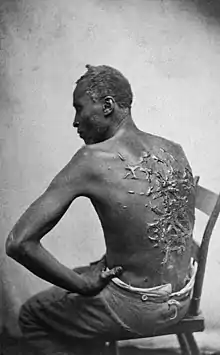 Gordon's back was deeply scarred from whippings by an overseer | |
| Born | Unknown |
| Died | Unknown, possibly late 19th century |
| Other names | Whipped Peter, Peter – Gordon is possibly a surname[1] |
| Known for | Pivotal figure in exposing the brutality of slavery |
| Military career | |
| Allegiance | |
| Service/ | |
| Rank | Sergeant |
| Unit | Corps d'Afrique |
| Battles/wars | |
In July 1863 these images appeared in an article about Gordon published in Harper's Weekly, the most widely read journal during the Civil War.[3] The pictures of Gordon's scourged back provided Northerners with visual evidence of brutal treatment of enslaved people and inspired many free blacks to enlist in the Union Army.[4] Gordon joined the United States Colored Troops soon after their founding, and served as a soldier in the war.[5]
Escape
Gordon escaped in March 1863 from the 3,000-acre (12 km2) plantation of John and Bridget Lyons, who held him and nearly 40 other people in slavery at the time of the 1860 census.[1][6] The Lyons plantation was located along the west bank of the Atchafalaya River in St. Landry Parish, between present-day Melville and Krotz Springs, Louisiana.[7]
To mask his scent from the bloodhounds that were chasing him, Gordon took onions from his plantation, which he carried in his pockets. After crossing each creek or swamp, he rubbed his body with the onions to throw the dogs off his scent. He fled over 40 miles (64 km)[8] over the course of 10 days before reaching Union soldiers of the XIX Corps who were stationed in Baton Rouge.[9]
Arrival at Union camp
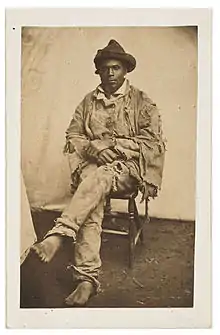
McPherson and his partner Mr. Oliver, who were in camp at the time, produced carte de visite photos of Gordon showing his back.[10]
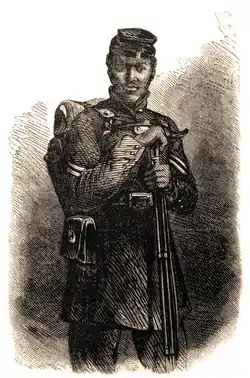
During the examination, Gordon is quoted as saying,
Ten days from to-day I left the plantation. Overseer Artayou Carrier whipped me. I was two months in bed sore from the whipping. My master come after I was whipped; he discharged the overseer.[11] My master was not present. I don't remember the whipping. I was two months in bed sore from the whipping and my sense began to come—I was sort of crazy. I tried to shoot everybody. They said so, I did not know. I did not know that I had attempted to shoot everyone; they told me so. I burned up all my clothes; but I don't remember that. I never was this way (crazy) before. I don't know what make me come that way (crazy). My master come after I was whipped; saw me in bed; he discharged the overseer. They told me I attempted to shoot my wife the first one; I did not shoot any one; I did not harm any one. My master's Capt. JOHN LYON,[7] cotton planter, on Atchafalya, near Washington, Louisiana. Whipped two months before Christmas.[5]
Service in Union Army
Gordon joined the Union Army as a guide three months after the Emancipation Proclamation allowed for the enrollment of freed slaves into the military forces. On one expedition, he was taken prisoner by the Confederates; they tied him up, beat him, and left him for dead. He survived and once more escaped to Union lines.[9]
Gordon soon afterwards enlisted in a U.S. Colored Troops Civil War unit. He was said to have fought bravely as a sergeant in the Corps d'Afrique during the Siege of Port Hudson in May 1863.[12] It was the first time that African-American soldiers played a leading role in an assault.[10]
Legacy
The Atlantic's editor-in-chief James Bennet in 2011 noted, "Part of the incredible power of this image I think is the dignity of that man. He's posing. His expression is almost indifferent. I just find that remarkable. He's basically saying, 'This is a fact.'"[13]
"I have found a large number of the four hundred contrabands examined by me to be badly lacerated as the specimen represented in the enclosed photograph." —J.W. Mercer, Asst. Surgeon 47th Massachusetts Volunteers, report to Colonel L.B. Marsh, Camp Parapet, Louisiana, 4 August 1863
—Dr. Samuel Knapp Towle, Surgeon, 30th Regiment of Massachusetts Volunteers, in a letter dated 16 April 1863 to William Johnson Dale, Surgeon-general of the State of Massachusetts. Dr. Towle was in charge of the 900-bed United States General Hospital, Baton Rouge in 1863.
The surgeon of the First Louisiana regiment, (colored,) writing to his brother in the city, encloses this photograph, with these words:
"—Picture of a Slave". The Liberator. Boston, Massachusetts. June 12, 1863. p. 2.I send you the picture of a slave as he appears after a whipping. I have seen, during the period I have been inspecting men for my own and other regiments, hundreds of such sights—so they are not new to me; but it may be new to you. If you know of any one who talks about the humane manner in which the slaves are treated, please show them this picture. It is a lecture in itself.
—Theodore Tilton, ed. (May 28, 1863). "The Scourged Back". The Independent (New York). XV (756): 4.
Reprint: "The Scourged Back". The Liberator. Boston, Massachusetts. June 19, 1863. p. 1.
In popular culture
- In the 2012 film Lincoln, Abraham Lincoln's son Tad views a glass plate of Gordon's medical examination photo by candlelight.[14]
- Emancipation, a film based on Gordon's escape, starring Will Smith and directed by Antoine Fuqua, is set to go into production in 2021. [15]
Gallery
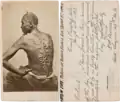 Medical examination photo
Medical examination photo Antique colored slide of Gordon during his 1863 medical examination (image is reversed left to right).
Antique colored slide of Gordon during his 1863 medical examination (image is reversed left to right). verso
verso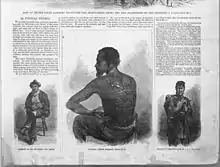 Harper's Weekly 1863 article
Harper's Weekly 1863 article Title page of an 1863 anti-slavery book
Title page of an 1863 anti-slavery book 1860 slave schedule for property of John Lyons. Gordon is likely one of the adult male slaves listed here by age.
1860 slave schedule for property of John Lyons. Gordon is likely one of the adult male slaves listed here by age.
References
Citations
- Abruzzo, Margaret (2011). Polemical Pain: Slavery, Cruelty, and the Rise of Humanitarianism. JHU Press. p. 309. ISBN 978-1421401270. Retrieved July 30, 2014.
- "The Scourged Slave's Back". The Liberator. Boston, Massachusetts. September 4, 1863. p. 3. Retrieved August 25, 2014 – via Newspapers.com.

- Heidler, David Stephen; Heidler, Jeanne T.; Coles, David J. (2002). Encyclopedia of the American Civil War: A Political, Social, and Military History. W. W. Norton & Company. p. 931. ISBN 978-0393047585.
- Goodyear III, Frank H. (October 7, 2011). "Photography changes the way we record and respond to social issues". Smithsonian Institution. Archived from the original on May 1, 2013. Retrieved August 26, 2013.
- Rymer, Eric. "Ten days from today I left the plantation". Historylink101. Archived from the original on July 28, 2014. Retrieved October 22, 2014.
- Population schedules of the eighth census of the United States, 1860, Louisiana. Reel 431 – St. Landry Parish. Washington : National Archives and Records Service, General Services Administration. 1965 [1860]. p. 111. OCLC 22655687. Retrieved January 4, 2015.
- Lyons Shaw, Adonica (n.d.). "Captain John Lyons of St. Landry Parish". Lyons Family website. Archived from the original on March 4, 2016. Retrieved July 30, 2014.
- "Civil War CDV of African American Contraband, Baton Rouge, La". Cowan's Auctions. Archived from the original on October 22, 2014. Retrieved October 22, 2014.
Civil War CDV of African American Contraband, Baton Rouge, La., 2008, Historic Americana Auction, Dec 4 & 5 with imprint of McPherson & Oliver, Baton Rouge, and verso inked inscription Contraband that marched 40 miles to get to our lines. An exceptional image.
- "A Typical Negro". Harper's Weekly: 429. July 4, 1863. Retrieved October 22, 2014.
- Shumard, Ann. "Bound for Freedom's Light". Civil War Trust. Archived from the original on May 21, 2013. Retrieved August 24, 2013.
- "Scars of slavery". The National Archives. Retrieved August 26, 2013.
- "A Picture for the Times". The Liberator. Boston. July 3, 1863. p. 3. Retrieved October 16, 2014 – via Newspapers.com.

- Norris, Michele (December 5, 2011). "'The Atlantic' Remembers Its Civil War Stories". NPR. Retrieved August 24, 2013.
- "Lincoln Script". IMSDb. Archived from the original on March 3, 2015. Retrieved January 19, 2015.
Tad, in fancy military uniform, sits on the bed, Gardener's box of glass negatives open beside him. He holds up a plate to a lamp:
- "Antoine Fuqua & Will Smith Runaway Slave Thriller 'Emancipation' To Be Introduced At Virtual Cannes Market; Based On Indelible 'Scourged Back' Photo". Deadline. Retrieved June 12, 2020.
Bibliography
- "Copy photograph of Gordon, a runaway slave". Yale University Library Catalog. 1863. Retrieved September 24, 2014.
- Silkenat, David (August 8, 2014). ""A Typical Negro": Gordon, Peter, Vincent Coyler, and the Story Behind Slavery's Most Famous Photograph" (PDF). American Nineteenth Century History. 15 (2): 169–186. doi:10.1080/14664658.2014.939807. S2CID 143820019.
Further reading
| Wikimedia Commons has media related to Gordon (slave). |
- Edwards, Ron (October 13, 2011). "The Whipping Scars On The Back of The Fugitive Slave Named Gordon". US Slave Blog. Retrieved August 24, 2013.
- Goodyear III, Frank. "The Scourged Back: How Runaway Slave and Soldier Private Gordon Changed History". America's Black Holocaust Museum. Archived from the original on January 5, 2015. Retrieved January 5, 2015.
- Paulson Gage, Joan (September 30, 2009). "A Slave Named Gordon". The New York Times. Retrieved August 24, 2013.
- Paulson Gage, Joan (August 5, 2013). "Icons of Cruelty". The New York Times. Retrieved August 24, 2013.
- Bostonian (December 3, 1863). "The Realities of Slavery". New-York Daily Tribune. p. 4. Retrieved June 27, 2015.
